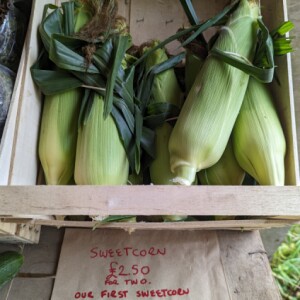Dark Eyes
Our organic veg supplier has planted a long, wide row of flowers, divided into a series of plots, each one containing a different species, or collection of species of pollinator-attractants. The honeybees were homing in on a plot of borage at one end. A plot of orange Welsh poppies was surprisingly popular. Various varieties of cosmos were enjoyed by the hoverflies. I was attracted to these black-eyed (or brown-eyed) Susan, partly because, in the afternoon light, the colours were rich and comforting, partly because of the perfectly-balanced beads of water on the horizontal flower - from rain that must have been several hours earlier, so it has balanced there, in the very light wind, for hours. Brown eyes with tears, homesick for Maryland and Mississipi
A notice beside the sweet corn in the honesty shop celebrates the first harvest for three years, because the last two have been wiped out by badgers. Badgers cannot, of course, reach the corn on the standing plant, but they have learned to push the standing stems horizontal with their forelegs, bringing the grain to ground level
Badgers have a conflicted position in our national life. Historically, badger-baiting was a common blood sport, and it would be naive to think it is entirely eradicated. In some contexts they are highly protected, with potential impact on the withholding of planning consent. They are celebrated in literature, especially childrens books, occupying a similar sentimental niche to robins, squirrels and hedgehogs. At the same time, they can be tiresomely destructive to commercial and private gardens. Most controversially, they have been linked to the transmission of bovine tuberculosis, resulting in a policy, in certain livestock areas, of culling by rifle fire to minimise the population, hoping the prevent the spread of the disease. The science behind the policy is disputed, and passions run understandably high on both sides of the debate. No wonder Susan is tearful



Comments
Sign in or get an account to comment.


